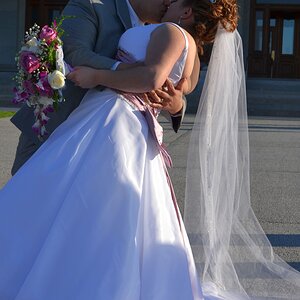Navigation
Install the app
How to install the app on iOS
Follow along with the video below to see how to install our site as a web app on your home screen.

Note: This feature currently requires accessing the site using the built-in Safari browser.
More options
You are using an out of date browser. It may not display this or other websites correctly.
You should upgrade or use an alternative browser.
You should upgrade or use an alternative browser.
Huge in bokeh difference between f/1.8 and f/2?
- Thread starter TonyUSA
- Start date
Destin
Been spending a lot of time on here!
- Joined
- Sep 11, 2010
- Messages
- 3,864
- Reaction score
- 1,383
- Location
- Western New York
- Can others edit my Photos
- Photos OK to edit
You are Wrong, plain and simple. DOF and Bokeh are two separate entities, but I will respect your right to be wrong in your own mind if it makes you happy.
And yet the appearance of bokeh continues to change as you change your aperture.
Weird.
Solarflare
No longer a newbie, moving up!
- Joined
- May 24, 2012
- Messages
- 2,898
- Reaction score
- 395
Exactly.Bokeh is the quality, the character, the look, the nature of, the out of focus areas.
Bokeh is how the unsharp areas are rendered.
Is it neutral ?
Is it soft ?
Is it creamy (Canon "dream lens" TV 50mm f0.95, Nikkor AF 105/135mm f2 DC even if you leave the DC alone, Tokina "Bokina" 90mm f2.5 macro) ?
Is it swirly (Petzval, Leica M Noctilux 50mm f1.0) ?
Is it circular (mirror lenses, certain old lenses) ?
Is it nervous ? (Nikkor AF 105/135mm f2 DC when you inverse the setting for the DC)
Is it deformed / catseye ?
Does it have the tendency to amplify structures in the background instead of blurring them ? For example Zeiss Planar 85mm f/1.4, as can be seen in this flickr pic: Talking on the phone [Carl Zeiss] [Explored] - even if some people might think thats still pretty, in this case.
Is it a mixture of the above, and what kind ?
And the ever subjective question: is it pretty ? Does it fit to the picture ?
The aperture blades / bokeh balls line of thinking is especially absurd. When does a lens have the smallest depth of field, the most blurr ? When its aperture blades are completely open. And guess what, then the aperture is always PERFECTLY ROUND !!!!!!!!!! So ... do these people really believe that Bokeh is always the same and perfect when a lens is shot wide open ?!?!?
Why, thats wrong. Bokeh is a property of the lens. Plain and simple. Just like any other lens attribute. Even if you statistically get certain Bokeh properties from other lens attributes, you cannot reliably conclude the quality of the Bokeh from the other lens attributes. Its a result of the lens formula - what lens elements, what glas types, etc - just like any other attribute of the lens.Things like spherical aberration, coma correction, diaphragm shape and placement within the lens, chromatic aberration correction levels, microcontrast, and more--all those things influence the character of the OOF areas; that is the original meaning of bokeh.
Quite frankly I have no idea why we would need any other than the original meaning for Bokeh.
Just like with any other question of beauty, the answer is ultimately subjective, even if most people will agree creamy Bokeh is pretty and nervous Bokeh ... not so much.There are only 4 kinds of Bokeh. Great, Good, Poor, and OMG that Sucks!!!
Derrel
Mr. Rain Cloud
- Joined
- Jul 23, 2009
- Messages
- 48,225
- Reaction score
- 18,941
- Location
- USA
- Website
- www.pbase.com
- Can others edit my Photos
- Photos OK to edit
Solarflare said:[
Why, thats wrong. Bokeh is a property of the lens. Plain and simple. Just like any other lens attribute. Even if you statistically get certain Bokeh properties from other lens attributes, you cannot reliably conclude the quality of the Bokeh from the other lens attributes. Its a result of the lens formula - what lens elements, what glas types, etc - just like any other attribute of the lens.Derrel said:Things like spherical aberration, coma correction, diaphragm shape and placement within the lens, chromatic aberration correction levels, microcontrast, and more--all those things influence the character of the OOF areas; that is the original meaning of bokeh.
Ummm,sorry dude, but you're the one who is wrong about this; how much uncorrected spherical aberration the lens designers allow to remain in the design; how much correction the lens has for coma; how much microcontrast the lens produces: the location and shape of the diaphragm within the optical path; how long the lens is (50,85,135,200mm,etc); all of those things, and more, are what makes up the lens design...the lens design consists of a multitude of factors. And all of the things I listed determine what type of bokeh a lens design has. Lens design determines bokeh. Bokeh is, ergo, a property of ALL of the lens design elements and properties. Maybe think it through a bit more next time?
fmw
No longer a newbie, moving up!
No. Bokeh is not semantics. It describes the quality of the OOF area. Period. Check out the DOF of the canon 50mm f1.8 and f1.4 at f2 and tell me that they are the same. The DOF and the Bokeh is totally different.
I'm not saying you'd see a difference in that case.
I'm saying that if you take an f/1.8 lens and stop it down to a smaller aperture, the out of focus area behind the point of focus is going to become less pronounced. So take that 50 f1.4 and compare an image at f1.4 with one at f4, and then another at f8... and then tell me that the bokeh is the same between the 3. It isn't: you'll have more pronounced bokeh wide open than stopped down. And therefore aperture affects bokeh. Period.
I'm not going to get tied up further in arguing the semantics of it or dragging this thread further away from the OP's question, so I'm leaving this thread following this post. I'll be out making photos while you all bicker about semantics.
Edit: I wanted to simply add that maybe this isn't how the term bokeh has traditionally been used. But in modern photography and language in general the meaning of *many* terms has changed over time. 99% of modern photographers use the term bokeh simply to describe the out of focus area that appears behind the point of focus.
Let me try again. 99% of modern photographers are wrong. Or you are wrong about the 99%. If you change aperture, you don't affect bokeh. You change the amount of out-of-focus highlights and their size. There is no question that the out of focus part of the image will look different at different apertures but that is an issue of quantity not quality.
Bokeh is a Japanese word that began being used to describe the rendered quality of the unfocused areas in the 1990's. It is possible that the meaning of the word has been corrupted over time. But, despite my lack of interest in bokeh, I have to agree that we need a term to describe out of focus quality. Bokeh is as good as any. Now, apparently we need a word to refer to the out of focus area itself. Perhaps you can come up with one. But not bokeh. It is already taken.
Derrel
Mr. Rain Cloud
- Joined
- Jul 23, 2009
- Messages
- 48,225
- Reaction score
- 18,941
- Location
- USA
- Website
- www.pbase.com
- Can others edit my Photos
- Photos OK to edit
Well, back to the 200mm lens. I do not have a lot of 200/2 shots on this computer or its storage drive, but I found a set shot under HORRIFICALLY windy conditions at a park in Vancouver, Washington, right down along the mighty Columbia River, where east winds often howl at 20 to 30 MPH, as they did on this day. It was unpleasantly windy. Chapped lips in an hour windy. Very unpleasant.This shoot was virtually a total washout due to extreme wind ruining probably 90 percent of all the frames. Hair, clothes, flapping all over the place. I used the VR to stabilize me against the wind, and it did well at 1/500 and 1/640 second.
A lot of the nature of bokeh depends on the background subject itself, but this set has point light sources from all the wind-ripples on the water. These are at f/4.5 for the close-up shot, and the last two were at f/5, as in f/5.0. So we have head-and-shoulders at f/4.5; a half-body shot at f/5, and a full-length shot at f/5.
As you can see, on a close-up type portrait with the camera close to the subject and a 200mm lens, even f/4.5 "blows out" and makes the background almost unrecognizable. When the camera to subject distance increases, so that a 200mm frames a person half-body, the bokeh dots on pinpoint light sources are medium in size, and the lens gives a pretty look to this type of backdrop, with the out of focus bokeh balls being fairly evenly-illuminated, and not with hard-edged "rings" around the outer circle, and also not with concentric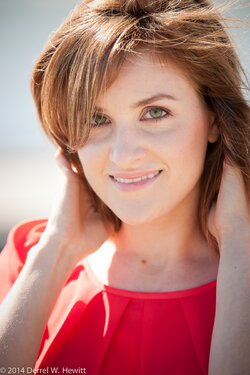
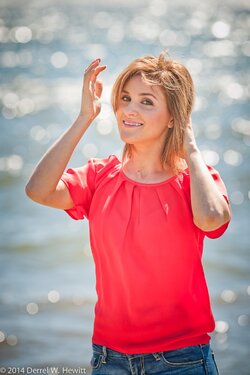
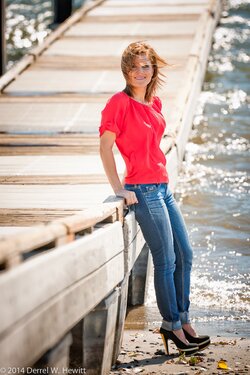 or "onion ring" type bokeh balls on the OOF highlights; when the camera moves back far enough to show a full-length person standing, the bokeh dots at f/5 are smaller, yet this lens has a nice, pleasant rendering of the overall scene's OOf areas.
or "onion ring" type bokeh balls on the OOF highlights; when the camera moves back far enough to show a full-length person standing, the bokeh dots at f/5 are smaller, yet this lens has a nice, pleasant rendering of the overall scene's OOf areas.
The Canon and Nikon 200mm f/2 lenses are really a PITA to carry and shoot. This was about the last time I used this lens. Just too doggone big and heavy to lug around when one wants to have other gear along.Tony, I would really advise you to listen to gryphonslair99, and look into the Canon 200mm f/2.8 prime lens if you want a single focal length 200mm lens, one that is actually carryable under normal, everyday situations, and one that does not warrant a monopod for every use longer than 20 minutes.
A lot of the nature of bokeh depends on the background subject itself, but this set has point light sources from all the wind-ripples on the water. These are at f/4.5 for the close-up shot, and the last two were at f/5, as in f/5.0. So we have head-and-shoulders at f/4.5; a half-body shot at f/5, and a full-length shot at f/5.
As you can see, on a close-up type portrait with the camera close to the subject and a 200mm lens, even f/4.5 "blows out" and makes the background almost unrecognizable. When the camera to subject distance increases, so that a 200mm frames a person half-body, the bokeh dots on pinpoint light sources are medium in size, and the lens gives a pretty look to this type of backdrop, with the out of focus bokeh balls being fairly evenly-illuminated, and not with hard-edged "rings" around the outer circle, and also not with concentric


 or "onion ring" type bokeh balls on the OOF highlights; when the camera moves back far enough to show a full-length person standing, the bokeh dots at f/5 are smaller, yet this lens has a nice, pleasant rendering of the overall scene's OOf areas.
or "onion ring" type bokeh balls on the OOF highlights; when the camera moves back far enough to show a full-length person standing, the bokeh dots at f/5 are smaller, yet this lens has a nice, pleasant rendering of the overall scene's OOf areas.The Canon and Nikon 200mm f/2 lenses are really a PITA to carry and shoot. This was about the last time I used this lens. Just too doggone big and heavy to lug around when one wants to have other gear along.Tony, I would really advise you to listen to gryphonslair99, and look into the Canon 200mm f/2.8 prime lens if you want a single focal length 200mm lens, one that is actually carryable under normal, everyday situations, and one that does not warrant a monopod for every use longer than 20 minutes.
Last edited:
Derrel
Mr. Rain Cloud
- Joined
- Jul 23, 2009
- Messages
- 48,225
- Reaction score
- 18,941
- Location
- USA
- Website
- www.pbase.com
- Can others edit my Photos
- Photos OK to edit
Yeah....it's not the weight as much as the terrible forward-torque or what I call nose-dive, that it puts on the wrist...it's so fat, and all the weight is just a few inches in front of the body. I found the 300/2.8 much easier to shoot hand-held or monopodded, and the 400/3.5 which is 96 ounces, is much easier too. Of all the big glass I've ever owned, the 200 f/2 had the absolute worst balance...just ungainly. Awkward. The 200/2 was okay on a monopod, but it's a bad lens for hand-held shooting.Just terrible balance, even with a D2x or D3x and a lot of weight as ballast. On a half-height body without a grip, it suuuuuuucked.
Well then you need to try this. Foods that make your butt bigger. That way you could counterbalance that thing. 

Destin
Been spending a lot of time on here!
- Joined
- Sep 11, 2010
- Messages
- 3,864
- Reaction score
- 1,383
- Location
- Western New York
- Can others edit my Photos
- Photos OK to edit
Yeah....it's not the weight as much as the terrible forward-torque or what I call nose-dive, that it puts on the wrist...it's so fat, and all the weight is just a few inches in front of the body. I found the 300/2.8 much easier to shoot hand-held or monopodded, and the 400/3.5 which is 96 ounces, is much easier too. Of all the big glass I've ever owned, the 200 f/2 had the absolute worst balance...just ungainly. Awkward. The 200/2 was okay on a monopod, but it's a bad lens for hand-held shooting.Just terrible balance, even with a D2x or D3x and a lot of weight as ballast. On a half-height body without a grip, it suuuuuuucked.
And from the looks of it, the tripod foot on at least the Nikon 200 f/2 is too small to be able to use as a handle. I could definitely see how that lens would be hard to hand hold.
Derrel
Mr. Rain Cloud
- Joined
- Jul 23, 2009
- Messages
- 48,225
- Reaction score
- 18,941
- Location
- USA
- Website
- www.pbase.com
- Can others edit my Photos
- Photos OK to edit
Speaking of tripod foot as handle/support: Years ago in the mid-80's I bought by first 300/2.8, the manual focus (internal focusing system) Tamron 300 SP-LD, which came with a thing called a palm rest. A sturdy piece of plastic, it screwed on directly to the tripod foot, and was SUPER-useful!!!! Here is what one looks like: Photo by Roy Strickland
Really, really helpful for a manual focusing lens, and it was also ergonomically designed to keep the lens up, above the palm, so the weight could be borne by the forearm bone, as it rand doewn toward the elbow, with the lens hoisted to shooting position. I would really like to have one or two of these. The 200 SHOULD have come with one of these. This accessory has never been popular, but it is a Godsend for hand-holding a heavy lens with the left palm. On a manual focusing lens with internal focusing, this palm rest left the left hand's thumb and all the fingers "free", and also elevated the lens an inch or more, so the fingers were naturally placed on the focusing ring. The difference the palm rest makes with a 300/2.8,etc is very significant. The Tamron palm rest is more comfortable than a hard-edged rectilinear tripod foot, and it gives much better use of the left hand thumb and fingers, AND it makes it so the weight is more easily transferred to,as I said, the forearm bones, and not so much onto the wrist joint itself. Hard to explain, but this was a major ergonomic improvement that just never caught on probably because monopods took over so fast by the mid-1980's.
Really, really helpful for a manual focusing lens, and it was also ergonomically designed to keep the lens up, above the palm, so the weight could be borne by the forearm bone, as it rand doewn toward the elbow, with the lens hoisted to shooting position. I would really like to have one or two of these. The 200 SHOULD have come with one of these. This accessory has never been popular, but it is a Godsend for hand-holding a heavy lens with the left palm. On a manual focusing lens with internal focusing, this palm rest left the left hand's thumb and all the fingers "free", and also elevated the lens an inch or more, so the fingers were naturally placed on the focusing ring. The difference the palm rest makes with a 300/2.8,etc is very significant. The Tamron palm rest is more comfortable than a hard-edged rectilinear tripod foot, and it gives much better use of the left hand thumb and fingers, AND it makes it so the weight is more easily transferred to,as I said, the forearm bones, and not so much onto the wrist joint itself. Hard to explain, but this was a major ergonomic improvement that just never caught on probably because monopods took over so fast by the mid-1980's.
Go to Hobby Lobby to their decorative door knob section and pick out one that fits your palm. Attach a 1/4" threaded rod and you are good. You may have to tap the knob to accept 1/4" threaded rod. Works wonderfully.
Destin
Been spending a lot of time on here!
- Joined
- Sep 11, 2010
- Messages
- 3,864
- Reaction score
- 1,383
- Location
- Western New York
- Can others edit my Photos
- Photos OK to edit
Those last two posts are super helpful! Thank you both!
Derrel
Mr. Rain Cloud
- Joined
- Jul 23, 2009
- Messages
- 48,225
- Reaction score
- 18,941
- Location
- USA
- Website
- www.pbase.com
- Can others edit my Photos
- Photos OK to edit
gryphonslair99 said:Go to Hobby Lobby to their decorative door knob section and pick out one that fits your palm. Attach a 1/4" threaded rod and you are good. You may have to tap the knob to accept 1/4" threaded rod. Works wonderfully.
Looks okay. That is the old Tamron manual focus lens! The doorknob looks okay, but the Tamron rest extended forward more, and was more slender, but that photo does give a good example of how the best position for the under-support of the lens is higher than can be had with tripod foot alone. I'm surprised that this type of device is not made by aftermarket parties like RRS or Manfroto, etc.. But seriously--once you've used a well-designed, good-fitting palm rest on a big lens hand-held, it is disappointing not to have one. Dustin--you might wanna try one of these for your big wildlife lens!
nickgillespie
TPF Noob!
- Joined
- Mar 10, 2017
- Messages
- 69
- Reaction score
- 16
- Location
- Asheville, NC
- Website
- www.bluebendphotography.com
- Can others edit my Photos
- Photos NOT OK to edit
I couldn't find anywhere in the 4 pages what you want this lens for. Do you have so much money that spending $5600 on a lens isn't an issue? If so, just go buy the thing.
If you are like the rest of us, come up with a reason that a $5600 lens is going to make you more money. I don't think there is a noticeable difference to any client.
If it were me, I'd do what you were thinking and get the 200 2.8 and the 135 f2. That 135 is a pretty freaking incredible portrait lens. Oh... and you'd still have enough money left over for the 85 1.2.
3 amazing lenses for the price of one.
If you are like the rest of us, come up with a reason that a $5600 lens is going to make you more money. I don't think there is a noticeable difference to any client.
If it were me, I'd do what you were thinking and get the 200 2.8 and the 135 f2. That 135 is a pretty freaking incredible portrait lens. Oh... and you'd still have enough money left over for the 85 1.2.
3 amazing lenses for the price of one.
Most reactions
-
 433
433 -
 284
284 -
 276
276 -
 266
266 -
 214
214 -
 183
183 -
 177
177 -
 170
170 -
 169
169 -
 167
167 -
 159
159 -
 128
128 -
 116
116 -
I
99
-
 94
94
Similar threads
- Replies
- 0
- Views
- 324
- Replies
- 20
- Views
- 2K


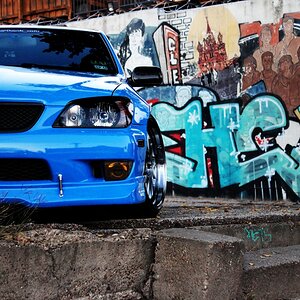
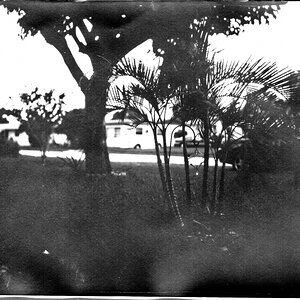
![[No title]](/data/xfmg/thumbnail/33/33448-e22f202a6b3be7233dba294543198f2e.jpg?1619735973)


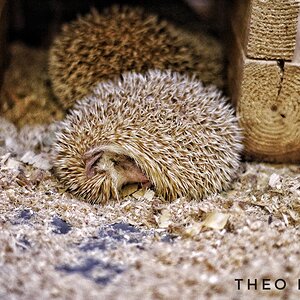

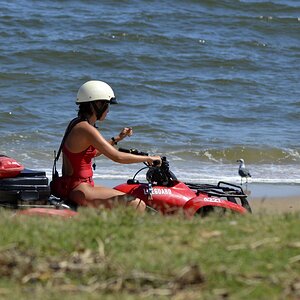
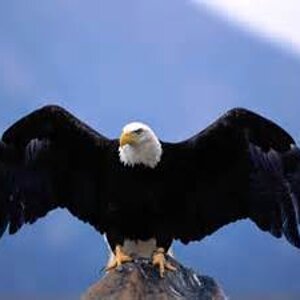

![[No title]](/data/xfmg/thumbnail/31/31978-02cde49248ebdf1b82fba5c899e08378.jpg?1619735136)
